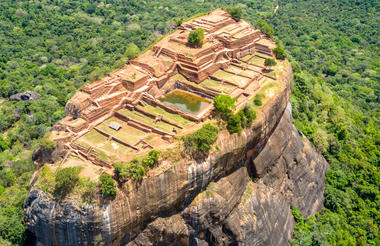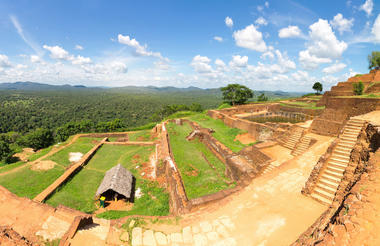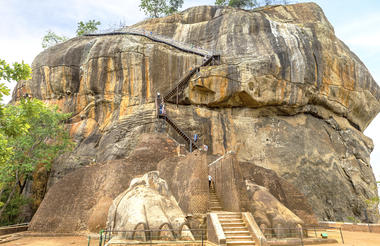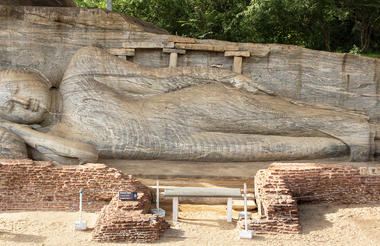You will be met at the airport by our representative and introduced to your chauffeur guide who will be accompanying you on your tour. The guide will remain with you until your stay unless we have advised you otherwise.



Polonnaruwa was the 2nd capital city of Sri Lanka, built in the 11th and 12th centuries AD, and which is also a World Heritage Site. Within the ruins of the Royal Palace, the Gal Viharaya, there are four splendid statues of the Buddha in 'Upright', 'Sedentary' and 'Recumbent' postures carved out of rock. In addition, the remains of stunning buildings including the Audience Hall, the Lotus Bath, king Parakramabahu's statue, and the Parakrama Samudraya lake built by King Parakramabahu the great, provide an insight into this great historic city. Polonnaruwa is also home to monuments of famous places of worship including the Shiva Temple, the Lankathilake, the Watadage, the Galpotha, the Kiri Vehera and the remains of a former Temple of the Tooth Relic, now found in Kandy. Approximately a one hour drive from Sigiriya, we recommend most clients visit Polonnaruwa in conjunction with Sigiriya during a stay in the Cultural Triangle. Visiting Polonnaruwa in the morning combines well with an afternoon Jeep Safari from Harbarana, in one the close-by national parks to see wild elephant and the vast array of local wildlife.
Minneriya National Park - Afternoon Jeep Safari
The Minneriya Tank was created by King Parakarambahu at the height of Polonnaruwa’s glory as the capital of Sri Lanka. The national park based largely around the huge tank (reservoir) was created rather more recently but serves as an important gathering place for Sri Lanka’s large population of elephants. It is a great place for elephant spotting all year round – though as the dry season makes water scarce between June and September, more and more elephants gather on the shores of Minneriya Tank.
Indeed by late August and September, the awe inspiring site of up to 300 elephants can often be seen, in a phenomenon known as ‘The Gathering’. It is the largest concentration and gathering of Asian elephants that can be seen anywhere in the world. Watching baby elephants playing with each other, bull elephants tussling for dominance and the great matriarchs surveying the scene is not a sight you are likely to forget in a hurry. Aside from the elephant, Minneriya is also home to some 23 other species of mammals: some, like the Deer and Sambur you will see, some like the Leopard and the Sloth Bear will probably prove elusive. The arid dry zone is a paradise for many species of Lizard and you will see them here in all their technical colour brilliance if you look carefully enough, as well as snakes like the Indian Python and the Mugger Crocodile. Above all, of course, are Sri Lanka’s wonderfully varied bird population. Among the 150 or so species, particular favorites of ours you may see in Minneriya include the beautiful painted stork, and various other bird species.



Morning
Sigiriya Rock Fortress
Sigiriya (Lion Rock) Referred by locals as the Eighth Wonder of the World this ancient palace and fortress complex has significant archaeological importance and attracts thousands of tourists every year. It is probably the most visited tourist destination of Sri Lanka. Sigiriya rock plateau, formed from magma of an extinct volcano, is 200 meters higher than the surrounding jungles. Its view astonishes the visitors with the unique harmony between the nature and human imagination. The fortress complex includes remnants of a ruined palace, surrounded by an extensive network of fortifications, vast gardens, ponds, canals, alleys and fountains. In the 3th century BC the rocky plateau of Sigiriya served as a monastery. In the second half of the 5th century king Kasyapa decided to construct a royal residence here. After his death Sigiriya again became a Buddhist monastery until the 14th century, when it was abandoned. The main entrance is located in the northern side of the rock. It was designed in the form of a huge stone lion, whose feet have survived up to today but the upper parts of the body were destroyed. The western wall of Sigiriya was almost entirely covered by frescoes, created during the reign of Kasyapa. Eighteen frescoes have survived to this day. The frescoes are depicting nude females and are considered to be either the portraits of Kasyapa’s wives and concubines or priestess performing religious rituals. One of the most striking features of Sigiriya is its Mirror wall. For those who are not comfortable with heights or have problems climbing we suggest the gardens of Sigiriya which are amongst the oldest landscaped gardens in the world. They are located in the western part of the rock with bridges, fountains, as well as surface and underground water pumps.



Morning
En route visit Dambulla Rock Temple.
Transfer from Sigiriya to Kegalle is approximately 2.5 Hours.
The Dambulla Rock Temple was donated by king Walagambahu in the 1st century BC to Buddhist monks. Dambulla is a World Heritage Site and is the most impressive of Sri Lanka's cave temples. The complex of five caves with over 2000 sq. meters of painted walls and the ceiling is the largest area of cave paintings found in the world. These caves contain over 1500 images of the Buddha of which the largest is the colossal figure of the Buddha carved out of rock spanning 14 meters. Close to the town of Dambulla this attraction is easily accessed although it requires walking up a considerable number of steps to reach the caves from the road. If you are a little short of time, a visit to the Dambulla rock temple can be combined with travelling to or from the Sigiriya area.



Morning
Elephant Freedom Project
This is a very special elephant encounter which is suitable for young and old, families, couples and single travellers. This is your chance to get a memorable impression of a day in the life of 2 Sri Lankan captive elephants who are not being used for working nor riding. The small family run Elephant Freedom Project offers refuge, freedom from work and hardship to the 2 elephants one named Kumani and the other Menik. At the project they are free from working in the riding industry and the wood logging. The Elephant Freedom Project aims to give them a good and safe home, which is made possible thanks to your visit!
To keep a relaxed and peaceful atmosphere for the elephant and you, they limit the number of visitors per day.
Visits to the Elephant Freedom Project start at 09:00 or 13:15 and can last for up to 4 hours.
Temple of the Sacred Tooth Relic Kandy
Kandy was the last capital of the Sri Lankan kings, and is a World Heritage Site. The name Kandy conjures visions of splendor and magnificence. Many of the legends, traditions and folklore are still lovingly kept alive. Drive around the Kandy Lake built by the last Sinhala king Sri Wickrama Rajasinghe in 1798. Visit the Kandy town and Bazaar, the arts & crafts center and a gem museum and a lapidary. In the evening visit the Dalada Maligawa Temple of the Tooth Relic believed to have belonged to Lord Buddha himself. Thereafter witness a cultural show featuring traditional Sri Lankan dancing.
The City is perhaps most famous for the annual Perahara, a most magnificent site which sees the scared tooth relic take to the streets accompanied by dancers, drummers and most significantly elephants dressed in all their finery and adorned with lights. The parade which goes through the streets of Kandy builds into a spectacular procession over ten consecutive nights with the number of elephants growing each night. Taking place annually at the end of July and in early August, with the date dependent upon the timing of the full moon, this is truly an experience not to be missed if your timing permits. The Kandy Perahara is considered to be one of the most spectacular pageants in Asia. During the Perahara, accommodation is at a premium in Kandy and needs to be reserved well in advance.
Kandy is also famous for the Peradeniya Royal Botanical Gardens - this botanical garden was first built as a pleasure garden by a Sinhala king and was expanded by the British during the period of colonial rule. It is 147 acres in extent and provides an amazing variety of trees, plants and flowers. It is also possible to have a guided tour of the spectacular botanical gardens with a botanist tour guide, for an extra cost.



You will have a chance to get in shallow water with the elephants. We recommend you take with you a small towel and have some water shoes to protect your feet whilst in the river.
Morning
Afternoon
Cooking Lesson
After a relaxed breakfast, at approximately 10:30 visit the organic kitchen garden with the Chef who, along with the gardener will explain the produce and some of the spices that is grown at Rosyth. On your return to the kitchen, you will have the opportunity to cook authentic Sri Lankan curries. You may be joined by other guests. The maximum number of guests is eight. The menu has been designed to include ingredients which are available in Europe. Your hands-on cooking class will include a fish or chicken curry and three other vegetable curries and a traditional salad. Sit down for lunch in the dining room in the canopy of the trees with the curries that you have cooked and enjoy your lunch with the rice and poppadum's. You will have the opportunity to take away the recipes to replicate at home. The curries: The main curries are Chicken, Fish or Mushroom. Green bean, Lentil and spinach, aubergine & Gotkola sambal. When you sit for lunch, we will serve you red or white rice, popadoms and homemade chutneys. You will have the recipes to take home and we suggest you purchase the spices from a supermarket before you fly home
Rosyth Artisanal Tea Experience
An Unique Complete Tea Experience of Leaf to Cup which will take place over two days. Join our ladies in the tea gardens to pluck a leaf; the green leaf is left to wither overnight at the micro factory and the next day, they can be hand rolled, fermented, dried and packed to take home. All proceeds will be given to the Rosyth Foundation which supports the local community and school.
Rosyth Estate House Tea
For decades the Rosyth Estate single origin tea had been processed at the local factory at the top our hill, which had been in operation since 1930. At 1,000 feet above sea level, the handpicked tea is used to produce orange pekoe in different grades and fannings, with the highest grade referred to as OP. Top quality pekoe grades consist mainly of buds and grading is based on the size of the individual leaves sorted in the finishing process. The size and the wholeness of the leaves has the greatest influence on the taste, clarity, and brewing time of the tea.
The Original 1930 Rosyth Tea Factory was not owned by the Rosyth Estate House and has been independently operated for generations. Unfortunately, following a tragic fire that took place in April 2022, the factory was destroyed leaving many in the local community without employment.
Rosyth Artisanal Tea – Their tea journey
At Rosyth, determined to move away from the traditional methods of producing tea that have remained the same since the colonial era, the owners have begun their journey to become an organic, artisanal producer of Sri Lankan tea. Removing much of the mechanisation from the processes they have started to produce hand crafted teas. The leaves are carefully manipulated by rolling or pounding on the estate by their local artisans. The micro factory was constructed in the first quarter of 2023 and they moved into production in the second quarter of 2023. The artisanal
This project is wholeheartedly community focused, as they look to improve the economic sustainability of the valley. Each and every person connected to production of the tea is now a partner with a stake in the future success. The partners will receive a guarantee of 10% of the estate tea revenues as a dividend payment on top of their wages. In the coming years, they hope the initiative will vastly increase the prosperity of our local community with the skills and investment to help it flourish. Artisanal Tea can be sold for
The process follows the classic steps of tea production but with an all together more personal and hands on approach:
Step one – Plucking: the fresh leaves are plucked by hand by our skilled tea pickers. For our highest quality hand rolled artisanal teas we delicately pick just one leaf and a young bud, carefully separating the slightly larger leaf which is hand processed separately. On arrival in the factory, the leaf is further inspected & any stalks removed.
Step two – Withering: the leaves are carefully laid out on withering trays, locally know at “Tats”. Tea leaves, even fresh tender ones are not pliable and would shatter when rolled and shaped. Drying gently on the tats, the leaf is left for up to 20 hours to gently wither, loosing up to 35% of its moisture content. As it withers, the leaf is gently turned to allow an even exposure to the air.
Step three – Hand Rolling: the withered leaves are now gently rolled by hand in wicker baskets by our artisans to gently break the cell structure of the leaf and to release the enzymes & natural oils within the leaf. Natural juices are slowly released, and the leaf becomes slightly sticky to the touch. Taking up to two hours to complete care is taken to maintain the structure of the leaf.
Step four – Oxidation: after completing the rolling, the leaf is left for up to two and half hours to allow oxidation to take place. This is the critical part of the process where the air interacts with the now exposed enzymes, heat is produced, and the flavour of the tea fully develops. The leaf turns a reddish-brown colour as the chemical composition changes & the wonderfully complex flavours of our tea develop. The time taken for oxidation varies, depending on a number of factors including the air temperature and the humidity levels, but as the chemical reactions develop and temperatures around 43c are reached, it is time to stop the oxidation and dry the tea.
Step five – Firing: time is now the essence, the tea needs to be dried, the oxidation process stopped, and leaves dried to perfection. In our artisan factory the leaf is spread onto the trays and placed into a drying over at temperatures between 85-110c. Good even drying, with low residual moisture levels, is essential to being able to store the tea, typically reached in one & a half hours.
Step six – Grading and sorting: once dried, the clock stops ticking and we can be more relaxed with final sorting and grading of the tea. Our highest quality OP grades are carefully sorted, before all the teas are packed into airtight foil bags to maintain the optimum freshness. Nothing is wasted, the small leaf particles carefully separated and blended to produce lower grade teas – in large commercial factories this would often end up in tea bags!
Guided Rosyth Estate Walk
A member of our team can guide you through the Estate and give you an appreciation of rural Sri Lankan life as you wind through paddy fields, jungle, fresh water streams and meet local villagers on the way. If he is not available, one of the hotel or estate team will accompany you on a guided at approximately 4pm. You may be joined by other guests,
Rosyth is a small working estate. Tea is plucked by hand and hand crafted into the artisanal tea factory. Latex is tapped by scoring the tree, then collected and and sold to a local rubber factory. Coconuts, fruits, spices and vegetables are grown on the estate and used at the hotel. You will be amazed by the variety of produce that grows on the estate!
If you prefer to walk on your own ask the team for some directions and enjoy forest bathing: immerse in nature .The Estate and its surroundings contain beautiful walking trails & mountain biking routes over the rolling hills. Guests are free to explore the estate and join the ladies plucking tea. Guides for two of our local walking trails, so you can independently explore the beautiful part of Sri Lanka’s Low Tea Country.



Day 8: Breakfast at the hotel and proceed to the airport for the departure flight to Maldives.
Today you will be transferred to the Airport for the departure flight. Our local representative or driver will be in touch to confirm the pickup time a day before your departure. We normally recommend aiming to be at the Airport 3 hours prior to departure to the Maldives.
The drive time to the Airport is approximately 2.5 hours.
Welcome to the tropical paradise of Maldives! After reaching there, get transferred by a speedboat to your resort and check-in to your room.
The rest of the days will be spent at Leisure.



Enjoy a hearty breakfast at the hotel and then check-out. A speed boat will await you for your transfer to the airport. Fly back home with wonderful memories of an amazing trip!




